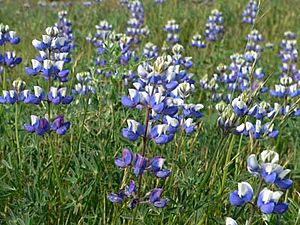Sky lupine facts for kids
Quick facts for kids Sky lupine |
|
|---|---|
 |
|
| Scientific classification | |
| Kingdom: | |
| (unranked): | |
| (unranked): | |
| (unranked): | |
| Order: | |
| Family: | |
| Subfamily: | |
| Tribe: | |
| Genus: | |
| Subgenus: | |
| Species: |
L. nanus
|
| Binomial name | |
| Lupinus nanus |
|
The Lupinus nanus is a beautiful wild flower. It is often called the "sky lupine" or "dwarf lupin." This plant is a type of lupine that grows naturally in the western United States. You can find it in places like California, Nevada, and on Steens Mountain in eastern Oregon. This plant likes to grow on hillsides and in open areas. It usually grows below 1,300 meters (about 4,265 feet).
It usually grows about 15 to 50 centimeters (6 to 20 inches) tall. Its flowers are a pretty blue color, often with white or yellow spots. The sky lupine is an annual plant. This means it grows, blooms, and dies all in one year. It typically blooms in March, April, and May. It's important to know that this plant is not safe to eat.
Types of Sky Lupine
The Lupinus nanus plant can look a bit different from one place to another. Scientists have found three main types, called subspecies. These are:
- Lupinus nanus subsp. latifolius – This is also known as the Sky Lupine.
- Lupinus nanus subsp. menkerae – This one is commonly called Menker's lupine.
- Lupinus nanus subsp. nanus – This is the main type of Sky Lupine.
Where Sky Lupines Grow
You can often find Lupinus nanus growing alongside other types of lupine plants. These might include Lupinus bicolor, Lupinus pachylobus, Lupinus micranthus, and Lupinus vallicola. They often grow together in the same areas.

